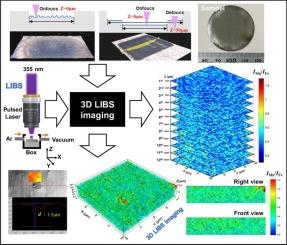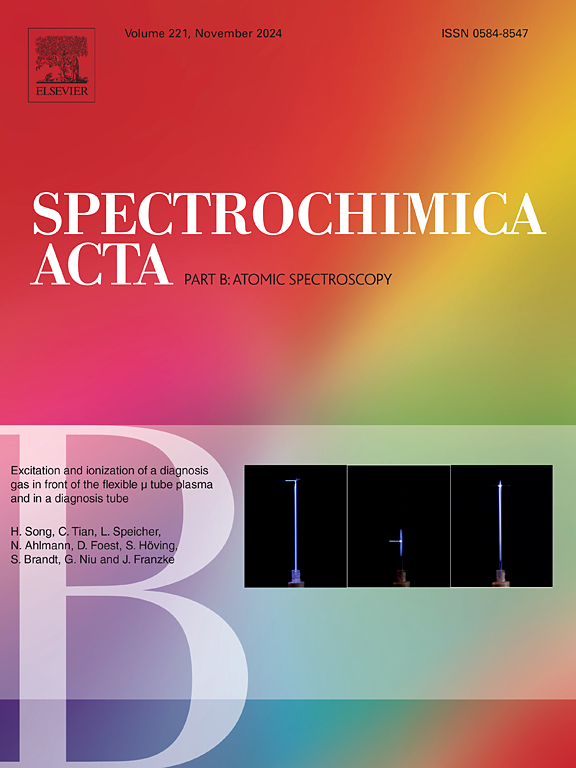基于皮秒激光诱导击穿光谱成像的铁偏析三维微观分析
IF 3.8
2区 化学
Q1 SPECTROSCOPY
引用次数: 0
摘要
元素显微分析在灰铸铁质量控制中起着至关重要的作用,而偏析监测是分析的重要环节。在这项研究中,我们开发了一种三维激光诱导击穿光谱(3D LIBS)系统,用于使用355 nm波长的9 ps脉冲激光检测灰铸铁,成功地实现了2 μm高空间分辨率的测量,以确定铜(Cu)和锰(Mn)的三维偏析。在实验方法方面,本研究克服了传统三维成像技术的局限性,放弃了依赖物理切片获取深度信息的传统方法。相反,它采用了一种更有效和非破坏性的策略:在激光散焦条件下进行测绘烧蚀清洗,以消除表面杂质或先前分析区域的干扰,然后使用精确聚焦的激光束进行3D LIBS成像。通过烧蚀理论公式,精确计算激光辐照下的轴向烧蚀深度为2 μm,从而获得共12层深度分辨数据,且各层信噪比稳定可靠。微尺度三维LIBS分析技术为了解灰铸铁材料中各种分离元素的分布模式提供了有力的工具。因此,3D LIBS已被证明是解决元素偏析的有效技术,可以作为灰口铸铁质量检测的替代方法。本文章由计算机程序翻译,如有差异,请以英文原文为准。

3D microanalysis of iron segregation based on picosecond laser-induced breakdown spectroscopy imaging
The elemental microanalysis plays a crucial role in gray cast iron quality control, and segregation monitoring is an essential step in this analysis. In this study, we developed a three-dimensional laser-induced breakdown spectroscopy (3D LIBS) system for examining gray cast iron using a 9 ps-pulsed laser operating at 355 nm. 2 μm high spatial-resolved measurements were successfully achieved to determine the 3D segregation of Copper (Cu), and Manganese (Mn). In terms of experimental methodology, this study has overcome the limitations of traditional three-dimensional imaging techniques by abandoning conventional approaches that rely on physical sectioning to acquire depth information. Instead, it adopts a more efficient and non-destructive strategy: performing mapping ablation cleaning under laser defocusing conditions to eliminate interference from surface impurities or previously analyzed regions, followed by 3D LIBS imaging implementation with precisely focused laser beams. Through the ablation theory formulas, the axial ablation depth under laser irradiation was precisely calculated as 2 μm, thereby obtaining a total of 12 layers of depth-resolved data while maintaining stable and reliable signal-to-noise ratios (SNR) for each layer. The microscale 3D LIBS analytical technique provides a powerful tool for understanding the distribution patterns of various segregated elements in gray cast iron materials. Therefore, 3D LIBS has been demonstrated as an effective technology for addressing elemental segregation and can serve as an alternative methodology for gray cast iron quality inspection.
求助全文
通过发布文献求助,成功后即可免费获取论文全文。
去求助
来源期刊
CiteScore
6.10
自引率
12.10%
发文量
173
审稿时长
81 days
期刊介绍:
Spectrochimica Acta Part B: Atomic Spectroscopy, is intended for the rapid publication of both original work and reviews in the following fields:
Atomic Emission (AES), Atomic Absorption (AAS) and Atomic Fluorescence (AFS) spectroscopy;
Mass Spectrometry (MS) for inorganic analysis covering Spark Source (SS-MS), Inductively Coupled Plasma (ICP-MS), Glow Discharge (GD-MS), and Secondary Ion Mass Spectrometry (SIMS).
Laser induced atomic spectroscopy for inorganic analysis, including non-linear optical laser spectroscopy, covering Laser Enhanced Ionization (LEI), Laser Induced Fluorescence (LIF), Resonance Ionization Spectroscopy (RIS) and Resonance Ionization Mass Spectrometry (RIMS); Laser Induced Breakdown Spectroscopy (LIBS); Cavity Ringdown Spectroscopy (CRDS), Laser Ablation Inductively Coupled Plasma Atomic Emission Spectroscopy (LA-ICP-AES) and Laser Ablation Inductively Coupled Plasma Mass Spectrometry (LA-ICP-MS).
X-ray spectrometry, X-ray Optics and Microanalysis, including X-ray fluorescence spectrometry (XRF) and related techniques, in particular Total-reflection X-ray Fluorescence Spectrometry (TXRF), and Synchrotron Radiation-excited Total reflection XRF (SR-TXRF).
Manuscripts dealing with (i) fundamentals, (ii) methodology development, (iii)instrumentation, and (iv) applications, can be submitted for publication.

 求助内容:
求助内容: 应助结果提醒方式:
应助结果提醒方式:


